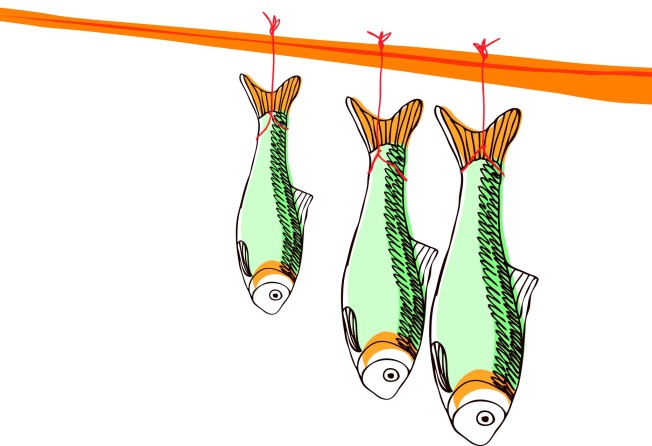Truc
Susan Jung

A few weeks ago, my neighbours could have been forgiven for thinking a Chinese granny had moved in next door. I had laid out on racks on the balcony, a good number of home-made salted fish drying on them in the sun and breeze.
It would have been much easier to go down to the dried-seafood shops of Queen's Road West to purchase salted fish, but I had some small fish leftover from a photo shoot. Rather than let them go to waste, I butterflied them, removing all but their backbones, and laid them flat. I covered them in a thick layer of sea salt and let them cure overnight in the fridge, to draw out as much liquid as possible. They were very small, thin fish; if they'd been larger, I would have salted them for longer. The next day, I put them out on the balcony to dry. I expected I'd have to swat away swarms of flies but, to my surprise, not a single insect was attracted to the fish. I let them dry for about a week, bringing the fish inside every evening and turning them over as needed, so they would dry evenly.
Fish are salted and dried in many countries with a coastline. Although it was originally a method employed to preserve fish, in modern times - when fresh ingredients are flown in from around the world, meaning there's rarely a shortage - it's used because the results taste good.
Salted fish - whether it's the cod preserved in countries such as Spain, Portugal and Italy, the haam yu we see in Hong Kong, or the kippers (smoked, which also dries them) eaten in Britain - has an intense flavour compared with fresh specimens, because when you remove the liquid, the flavour becomes more concentrated.
With some types of salted fish, such as bacalhau, the intensity becomes muted during preparation for cooking as they're soaked for several hours in repeated changes of water to rehydrate them and remove excess salt. If that wasn't done, the fish would be too salty to eat. With other salted fish, including haam yu and kippers, the fish aren't soaked (although they may be rinsed), so the salt and intensity need to be taken into consideration when cooking.
Haam yu is usually used in small quantities or is cut up into tiny pieces to flavour a dish. On occasion, though, I have eaten fried whole haam yu, which is delicious when served with a bowl of white rice and sautéed bitter vegetables.
The same thing applies to kippered fish, even though they're not as salty as haam yu or bacalhau. A grilled whole kipper, eaten with potatoes and poached egg, can be delicious for breakfast, and a small amount of the fish can be used to flavour fish cakes, seafood pies and kedgeree.
Truc (tryk): noun, masculine, trick, gimmick, device. A French word for a chef's secret.